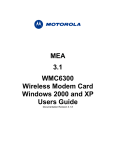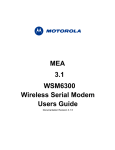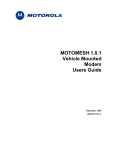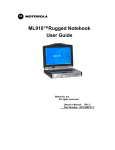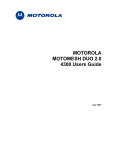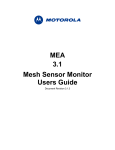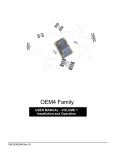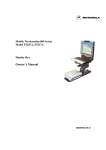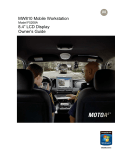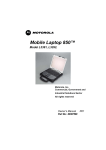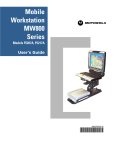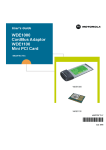Download Motorola 3.1.3 Network Router User Manual
Transcript
MEA Enhanced Wireless and Portable Wireless Routers Users Guide Documentation Revision 3.1.3 Mesh Enabled Access EWR/PWR Users Guide Copyrights The Motorola products described in this document may include copyrighted Motorola computer programs. Laws in the United States and other countries reserve for Motorola certain exclusive rights for copyrighted computer programs. Accordingly, any copyrighted Motorola computer programs contained in the Motorola products described in this document may not be copied or reproduced in any manner without the express written permission of Motorola. Furthermore, the purchase of Motorola products shall not be deemed to grant either directly or by implication, estoppels or otherwise, any license under the copyrights, patents or patent applications of Motorola, except for the normal nonexclusive, royalty-free license to use that arises by operation of law in the sale of a product. Disclaimer Please note that certain features, facilities and capabilities described in this document may not be applicable to or licensed for use on a particular system, or may be dependent upon the characteristics of a particular mobile subscriber unit or configuration of certain parameters. Please refer to your Motorola contact for further information. Trademarks Motorola, the Motorola logo, and all other trademarks identified as such herein are trademarks of Motorola, Inc. All other product or service names are the property of their respective owners. Copyrights © 2007 Motorola, Inc. All rights reserved. No part of this document may be reproduced, transmitted, stored in a retrieval system, or translated into any language or computer language, in any form or by any means, without the prior written permission of Motorola, Inc. iii Table of Contents 1 PRODUCT INTRODUCTION ................................................................................... 1 1.1 2 Product Contents ......................................................................................................1 DEVICE INSTALLATION......................................................................................... 2 2.1 Installation Requirements ........................................................................................2 2.1.1 Enhanced Wireless Router (EWR)............................................................................... 2 2.1.2 Portable Wireless Router (PWR).................................................................................. 2 2.2 Software Requirements ............................................................................................2 2.3 Equipment Requirements.........................................................................................3 2.4 2.5 2.6 2.3.1 EWR6300 ..................................................................................................................... 3 2.3.2 PWR6300 ..................................................................................................................... 3 MAC Address Label Location ..................................................................................4 2.4.1 EWR ............................................................................................................................. 4 2.4.2 PWR ............................................................................................................................. 4 2.4.3 MAC Address Table ..................................................................................................... 4 EWR6300 Assembly Information .............................................................................6 2.5.1 EWR6300 Assembly..................................................................................................... 6 2.5.2 EWR Installation procedure:......................................................................................... 6 2.5.3 EWR6300 Mounting Bracket ........................................................................................ 6 PWR6300 Assembly Information .............................................................................9 2.6.1 2.7 Device Deployment Considerations ......................................................................10 2.7.1 2.8 3 PWR Installation Procedure ....................................................................................... 10 Antenna Deployment Tips .......................................................................................... 11 Testing the Device Installation...............................................................................11 DEVICE CONFIGURATION................................................................................... 12 3.1 IP Addressing Considerations ...............................................................................12 3.2 Accessing the MEA Device Administration Web Pages......................................12 3.2.1 User Name and Administrator Access Information .................................................... 12 3.2.2 Viewing MEA Redirecting Page ................................................................................. 14 3.2.3 Viewing MEA Device Administration Home Page ...................................................... 15 3.2.4 3.2.3.1 Viewing MEA Device Administration Home Page as a Normal User......... 16 Viewing the EWR Device Administration Configuration Tab...................................... 17 3.2.4.1 3.3 Viewing the EWR Device Configuration Tab as a Normal User ................ 18 Device Addressing Schemes .................................................................................20 3.3.1 Network DHCP Scheme ............................................................................................. 20 iv Mesh Enabled Access 3.3.2 Statically Provisioned Scheme ................................................................................... 20 3.3.3 User Supplied Scheme............................................................................................... 21 3.3.3.1 3.4 Connecting to the Ethernet Port ................................................................................. 24 DEVICE MAINTENANCE ...................................................................................... 25 4.1 Resetting the EWR via the Device Administration Web Page.............................25 4.2 Restoring Factory Settings – User Supplied Mode Limitations..........................27 4.2.1 Recovering from EWR/PWR Reset-to-Default in User-Supplied Mode ..................... 27 4.2.1.1 Resetting Device Addressing Mode Using Device Manager ..................... 27 4.2.1.2 Resetting Device Addressing Mode via Configuration Web Page............. 27 4.2.1.3 Resetting User-Supplied Parameters via Configuration Web Page .......... 27 4.3 Restoring Factory Settings – Normal Operations ................................................28 4.4 Changing the Web Interface Password.................................................................30 4.5 Security Provisioning Web Page ...........................................................................32 4.6 5 Setting User Supplied IP Addresses .......................................................... 21 External Device Provisioning.................................................................................23 3.4.1 4 EWR/PWR Users Guide 4.5.1 Provision Username Section ...................................................................................... 32 4.5.2 Provision Groupname Section.................................................................................... 32 Upgrading the Device Firmware ............................................................................33 CUSTOMER SERVICE INFORMATION................................................................ 35 5.1 Obtaining Support...................................................................................................36 5.1.1 5.2 System Information..................................................................................................... 36 Return Material Request .........................................................................................36 5.2.1 Radio Products and Services Division ....................................................................... 36 5.2.2 5.2.1.1 Radio Products and Services Division Telephone Numbers ..................... 37 Returning System Components to Motorola .............................................................. 37 5.2.3 Returning FREs .......................................................................................................... 37 6 WARRANTY INFORMATION ................................................................................ 38 7 FCC REGULATORY INFORMATION ................................................................... 41 7.1 FCC Information ......................................................................................................41 7.2 FCC RF Energy Exposure Statement ....................................................................41 7.3 Regulatory and RF Safety Exposure .....................................................................41 v List of Figures Figure 2-1 EWR6300 Identification Label Example.............................................................4 Figure 2-2 PWR6300 Identification Label Example.............................................................4 Figure 2-3 EWR6300 External Connection Points ..............................................................6 Figure 2-4. EWR6300 Mounting Bracket...............................................................................7 Figure 2-5. C-Clamp Bracket Assembly................................................................................8 Figure 2-6. EWR Pivot and Angle Locking Bolts .................................................................9 Figure 2-7. PWR External Connection Point ........................................................................9 Figure 2-8 PWR6300 Cabinet Mounting.............................................................................10 Figure 3-1 Enter Network Password Initial Web Page Authentication Dialog ...............13 Figure 3-2. MEA Device Administration Redirecting Web Page.......................................14 Figure 3-3. MEA Device Administration Home Page (Super User Login)........................15 Figure 3-4. MEA Device Administration Home Page (Normal User Login) .....................16 Figure 3-5. EWR (PWR) Device Configuration Page (Super User Login) ........................17 Figure 3-6. EWR (PWR) Device Configuration Page (Normal User Login) ......................19 Figure 3-7. Configuration Change Dialog...........................................................................21 Figure 3-8. System Update Save Completed Web Page ...................................................22 Figure 3-9. External Device Provisioning Table.................................................................23 Figure 4-1. Device Reset Prompt Web Page ......................................................................25 Figure 4-2. Device Reset in Progress Page........................................................................26 Figure 4-3. Restore Factory Settings Web Page................................................................28 Figure 4-4. Confirm Changes Window for Restore Factory Settings ..............................29 Figure 4-5. Factory Settings Restored Web Page..............................................................29 Figure 4-6. Enter New Password Web Page.......................................................................30 Figure 4-7. Confirm Changes Window for Enter New Password .....................................30 Figure 4-8. Password Changed Confirmation Web Page..................................................31 Figure 4-9. Security Provisioning Web Page .....................................................................32 Figure 4-10. Update Device Firmware Web Page.................................................................33 vi Mesh Enabled Access EWR/PWR Users Guide Figure 4-11. Confirm Upload Window for Firmware Update...............................................34 Figure 4-12. Firmware Upload Progress Web Page.............................................................34 vii Mesh Enabled Access EWR/PWR Users Guide 1 Product Introduction Thank you for purchasing the MEA Enhanced Wireless Router (EWR) or the MEA Portable Wireless Router (PWR). Both of these devices are designed to integrate with the Mesh Enabled Access (MEA®) wireless communication system capable of supporting high data rate mobile communication at variable rates of vehicular speeds. This document provides detailed installation and configuration instructions for installing the MEA EWR and PWR. The EWR is designed to be deployed outdoors, while the PWR is designed for indoor use, such as traffic cabinets or inside outdoor kiosks. Both of these devices offer wireless coverage in large geographic areas and provide wireless network access to one or more IP devices via a built-in RJ45 Ethernet port. Both the EWR and the PWR efficiently combine the functionality of a Motorola Wireless Router and client modem into a single cost-effective wireless network component. This makes it easy for any Ethernet-ready device to access a Mesh Enabled Access (MEA), mobile broadband network. IP-enabled computers, video cameras, sensors, signs, signals, and other devices can all be Mesh Enabled to send and receive data at burst rates of up to 6 Mbps. All standard Wireless Router functionality including Multi-Hopping®, near Line-of-Sight communications, and geo-location services are fully supported. The EWR and the PWR are configured for the connection of multiple IP addressable devices using standard Ethernet connectivity. This allows devices that cannot accept the PCMCIA based WMC6300 product to function transparently on a MEA network without drivers 1.1 Product Contents Each MEA EWR and PWR is a full-featured wireless networking device. The following is a list of the items provided with each device: EWR • MEA Enhanced Wireless Router • 1 Field Attachable Sealed Ethernet Boot • High Gain Antenna • Power Cord PWR • MEA Portable Wireless Router • 15 foot cable assembly • PWR cable connector (end 1): Switchcraft EN3C2F • PWR cable connector (end 2): Molex 19121-009 spade lugs • Mag Mount Antenna 1 2 Device Installation 2.1 Installation Requirements 2.1.1 Enhanced Wireless Router (EWR) The MEA Enhanced Wireless Router 6300 (EWR6300) is an infrastructure device positioned in a fixed location, such as on a pole, wall, or rooftop. The device requires professional installation to ensure the installation is performed in accordance with FCC licensing regulations. The EWR provides range extension, a means to route around obstructions, a fixed location reference for use in Geo-Location, and the capability of enabling IP devices. The EWR6300 comes with a mounting bracket that can be attached to a pole with a diameter of 1-3.5 inches. For correct MEA deployment, a power source for each EWR must be provided. 2.1.2 Portable Wireless Router (PWR) The PWR6300 Portable Wireless Router (PWR) has the same functionality as the EWR, including network routing, Multi-Hopping®, and geo-location services, but in a smaller form. It combines the functionality of a Wireless Router and the Wireless Modem Card into a single device. Adding an Ethernet port to a Wireless Router enables video cameras, computers or any other Ethernet-capable device to get high-speed access to the MEA wireless broadband network, without the need to purchase a separate Wireless Modem Card. The MEA Portable Wireless Router 6300 (PWR6300) is an infrastructure device positioned in a fixed location, such as on a traffic cabinet or outdoor kiosk. The PWR6300 provides range extension, a means to route around obstructions, a fixed location reference for use in Geo-Location, and the capability of enabling IP devices. 2.2 Software Requirements Two types of software interfaces will be required during the installation and setup process of the EWR and PWR device: MeshManager and the EWR Device Administration web interface. MeshManager software needs to be installed and running on a network computer prior to EWR and PWR installation and configuration. MeshManager will be used in the EWR and PWR setup process to validate the installation of the device. MeshManager software will also be used to manage an EWR, PWR, and other subscriber devices within the MEA network. The EWR Device Administration web interface is also utilized by the PWR and is used to administer and configure the device. The web interface can be accessed by connecting a PC to the wired interface. Additional information is provided later in this manual. Detailed information about MeshManager software and its usage is found in the following publications: QuickStart for MeshManager and MeshManager Users Guide. 2 Mesh Enabled Access 2.3 EWR/PWR Users Guide Equipment Requirements An EWR6300 and a PWR6300 are utilized similarly to a subscriber device within a MEA network. Both will be used with the following Motorola’ infrastructure devices: IAP6300 and MWR6300. 2.3.1 EWR6300 The following list defines the standard MEA hardware components needed to set up a EWR: • EWR Box with N-type Antenna Connector • 120V A/C Power Cable with a NEMA 5-15 plug • Antenna with N-type Male Antenna Connector • Mounting Bracket The Network Operator must supply the following: • Mounting Location • Power Source (120V A/C or 5 V D/C depending on EWR configuration) • Hand tools for bracket installation (7/16” wrench (2), Phillips screwdriver) Optional Equipment: • DC powered EWR (EWR6300-DC-IN) • Power cord to connect to a photoelectric cell 2.3.2 PWR6300 The following list defines the standard MEA hardware components to install a PWR: • PWR Box with N-type Antenna Connector • 15 feet cable assembly • Mounting Bracket The Network Operator must supply the following: • Mounting Location • Power Source (12 VDC) • Hand tools for bracket installation Optional Equipment: • An Antenna Cable and connector 3 2.4 MAC Address Label Location 2.4.1 EWR The transceiver Media Access Control (MAC) address and the Ethernet MAC address is typically listed on a label located on the antenna end of the EWR6300. A sample label is shown in Figure 2-1. Record the transceiver MAC Address and Ethernet MAC Address in the MAC Address Table below, as they will be required later to configure and test the device. Ethernet MAC Address Figure 2-1 EWR6300 Identification Label Example Transceiver MAC Address 2.4.2 PWR The transceiver and Ethernet MAC addresses are recorded on a label located on the PWR unit. Record these numbers in the MAC Address Table, as they will be required later to configure and provision the device. Figure 2-2 PWR6300 Identification Label Example 2.4.3 MAC Address Table The MAC Address table has been included for recording the Ethernet MAC address and transceiver MAC address for a set of EWR and PWR devices as a quick reference. These 4 Mesh Enabled Access EWR/PWR Users Guide addresses will be required later in the configuration and management process. Write the MAC numbers into the MAC Address Table provided below. MAC Address Table MAC Address (00-05-12-0A-xx-yy) ETH MAC Address (00-05-12-30-xx-yy) 5 2.5 EWR6300 Assembly Information The EWR6300 Assembly information will be described in the following subsections. 2.5.1 EWR6300 Assembly Antenna Connector Power Out (3-pin) Power In (4-pin) (optional) Test Port RJ45 (Data) Port (Not Shown) Figure 2-3 EWR6300 External Connection Points 2.5.2 EWR Installation procedure: The following instructions describe the EWR6300 hardware installation procedure: 1. If desired, mount the EWR box using the enclosed bracket. Refer to the EWR6300 Mounting Bracket section for detailed information. 2. Insert the Antenna into the N-type Connector on the top of the box, and tighten. 3. Insert the Power Plug into the 4-pin Connector and tighten. 4. Verify the MAC address and Ethernet (ETH) address has been recorded in Section 2.4.3. Both addresses will be required to configure and test the device. 5. The Test Port is unused during deployment. 2.5.3 EWR6300 Mounting Bracket The EWR6300 mounting bracket is identical to the mounting bracket for the IAP6300 and the MWR6300. The bracket is robust secure; and can be used for horizontal, vertical, and off-angle pole mounted installations. The mounting bracket is preinstalled and supplied with two 3 1/2 x 1/4 inch stainless steel bolts. The mounting bracket can accommodate up to a 3 1/4 inch diameter mounting pole. Substitute for the 1/4-inch bolts supplied with the bracket may be used to accommodate mounting poles smaller than 3 inches. Motorola strongly recommends the use of stainless steel mounting hardware to prevent corrosion. The standard mounting hardware supplied with the bracket is stainless steel. The bracket is made of aluminum. The following procedure outlines the required steps for installing a MEA EWR6300 using the bracket shown in Figure 2-4. 6 Mesh Enabled Access EWR/PWR Users Guide Figure 2-4. EWR6300 Mounting Bracket 1 Using the deployment guidelines described in the MEA Setup and Deployment User’s Guide, locate an appropriate mounting pole such at a streetlight cobra arm or a metal post. The mounting pole can be vertical, horizontal, or project at almost any angle. 2 Remove one of the C-Clamp Bracket bolts so that the bracket can be positioned around the mounting pole. If necessary, remove the second bolt. When the two halves of the Clamp Bracket are correctly positioned, reinstall the bracket bolts. Note: The C-Clamp Bracket Assembly requires two 3 1/2 x 1/4 inch stainless steel bolts to secure the C-Clamp to a mounting pole. Each bolt is supplied with (2) stainless steel flat washers, (1) lock washer, and (1) stainless steel nut. The bracket hardware should be installed as indicated in Figure 2-5. 7 3 1/2 x 1/4 inch bolt 1/4 Flat Washer 1/4 Flat Washer 1/4 Lock Washer 1/4 Hex Nut Note: All Hardware is Stainless Steel Figure 2-5. C-Clamp Bracket Assembly 3. Position the bracket in the desired location and securely tighten the two bracket bolts. 4. If required, loosen the Pivot Bolt and the Angle Locking Bolt (Figure 2-6) so that the antenna connector is positioned vertically. 5. Ensure that the antenna connector is still vertical and tighten the Pivot Bolt using a 7/16inch open-end wrench or socket wrench. 6. Tighten the Angle Locking Bolt using a #1 Phillips screwdriver. 8 Mesh Enabled Access EWR/PWR Users Guide 6 x 32 x 3/4 Angle Locking Bolt 1/4 x 1 inch Pivot Bolt (Requres 7/16 Wrench) Figure 2-6. EWR Pivot and Angle Locking Bolts NOTE: Some IAP6300 and MWR6300 enclosures may have a bolt or plug in the center of the back of the box. To maintain the integrity of the box, DO NOT REMOVE THIS PLUG. 2.6 PWR6300 Assembly Information The VMM6300 Assembly shows the external connection points on a VMM6300 box. Power Connector Ethernet (Crossover MDI-X) Figure 2-7. PWR External Connection Point 9 Power Reset N-Type Antenna Connector 2.6.1 PWR Installation Procedure The following instructions describe the PWR6300 hardware installation procedure: 1. Mount the PWR in a traffic cabinet or kiosk. The device is not waterproof and should be reasonably protected from moisture and other exposed outdoor environments. 2. Connect the antenna to the N-type connector. 3. Insert the Power Plug into Power Connector. 4. Verify the transceiver and Ethernet MAC address have been recorded in Section 2.4.3, as it will be required to configure and test the device. 5. The Test Port is unused during deployment. Figure 2-8 2.7 PWR6300 Cabinet Mounting Device Deployment Considerations When deploying the EWR6300 or the PWR6300 consider the following: • The antenna should be a minimum of 30 inches from any nearby metal poles to avoid distortion of the RF pattern. • The antenna must have a separation distance of at least 2 meters from the body of all persons and must not be co-located or operating in conjunction with any other antenna or transmitter. • Users and installers must be provided with antenna installation and transmitter operating conditions to satisfy RF exposure compliance. • Typically, the EWR and the PWR are distributed within a network and are used as subscriber devices. A rule of thumb is to deploy 2-3 hop networks to optimize range, latency, and throughput to subscriber devices. • It is required that the EWR/PWR chassis be grounded to minimize the possibility of ESD (electrostatic discharge) induced damage. 10 Mesh Enabled Access EWR/PWR Users Guide 2.7.1 Antenna Deployment Tips Locate the antenna to minimize multipath: - Minimize interference from nearby transmitters - Maximize chance of a direct line of sight connection to other devices. - Mount the supplied antenna vertically 2.8 Testing the Device Installation Verify the operation of each installed EWR6300 and PWR device using the following procedure: 1. Apply power to the EWR6300 or the PWR6300, as applicable. (On the PWR device, the power reset button will be illuminated to red.) 2. Obtain the transceiver MAC address and the Ethernet address that was recorded earlier in the MAC_Address_Table section of this document. The address will be in the format 00-0512-0A-xx-yy for the transceiver and 00-05-12-30-xx-yy for Ethernet. 3. From the MeshManager software screen, display the devices using the Display MAC Addresses selection from the Preferences menu Note: This step assumes that the device has been automatically detected via the Auto-Add feature, or manually added using the Add New Device menu item in MeshManager. 4. Within the MeshManager software screen, select the appropriate EWR or PWR in the EWR device tree. Note: The same EWR template is used for both device types. 5. Within the MeshManager software screen, right-click on the device MAC address and select the Ping option. A successful response to the Ping command verifies that the EWR or PWR is successfully communicating to the infrastructure devices. 11 3 Device Configuration The Device Configuration information provided in this section applies to both the EWR and the PWR devices due to their functional similarities. It is important to note that within the MeshManager Software and the Device Administration Web interface, any reference made to a EWR device is also applicable to a PWR. 3.1 IP Addressing Considerations The EWR and PWR provide network access to one or more IP devices connected to the onboard Ethernet port. In order for the EWR or the PWR to provide service to the IP devices, some configuration must be set up prior to connecting the IP devices. The local default gateway address is used only on the wired interface, and is only visible to the attached IP devices. It is not advertised to the wireless network, and the network cannot access the EWR/PWR using this gateway address. The EWR/PWR has another IP address for the wireless interface that can be used to access the EWR/PWR from the network. Because this gateway address is limited to the local wired interface, the same address could be used for the gateway service in several EWR/PWR devices. The local gateway should be a part of the overall subnet chosen for your MEA network. Care must be taken to ensure that the selected IP address is on the same subnet, and does not conflict with any other devices or the chosen Local Gateway service address on the MEA network. 3.2 Accessing the MEA Device Administration Web Pages To modify the IP configuration for the EWR/PWR using the web interface, you must know the IP address assigned to the EWR/PWR SBC. The mechanism for assigning the IP address is controlled by the addressing mode of the EWR/PWR SBC. Regardless of the mechanism, the assigned IP address can always be displayed using MeshManager. If the factory setting is used, then the default addressing mode will be Remote DHCP, and the EWR/PWR SBC IP address will be assigned by the network DHCP server. If the SBC addressing mode was changed to Statically Provisioned, and an IP address was entered, then the entered IP address will be used. If the SBC addressing mode was changed to Statically Provisioned, but no IP address was entered, then the default SBC IP address will be derived from the transceiver MAC address (10.xx.yy.1, where the MAC address is 00:05:12:0A:XX:YY), similar to the default IP addresses described in the External Device Provisioning section. XX and YY are hex values from the transceiver MAC address, and the lowercase xx and yy are the same values in decimal. For example, a EWR/PWR with a transceiver MAC address of 00:05:12:0A:80:20 would have a default SBC IP address of 10.128.32.1. Once the IP address is known, the device web page can be accessed by pointing your web browser to the IP address of the EWR/PWR SBC. For example, if the EWR/PWR SBC address is 10.128.32.1, then the web page would be found at http://10.128.32.1/. 3.2.1 User Name and Administrator Access Information The device has two accounts for the web interface - an administrative account (username:admin, default password:admin), and an access account (username: monitor, default password: monitor). The administrative account must be used for provisioning the device, and 12 Mesh Enabled Access EWR/PWR Users Guide the access account may be used for monitoring the status of the device. The installation procedure described here requires Administrator access. Alternatively, all of the parameters that are provisioned via the web page may be provisioned via MeshManager instead. The password for the admin account should be changed during installation. The Access or Normal User account password can be changed by the Administrator. NOTE: If you are running a EWR/PWR as a standalone device, the configuration web page can be reached by connecting a PC to the wired interface. Figure 3-1 Enter Network Password Initial Web Page Authentication Dialog 13 3.2.2 Viewing MEA Redirecting Page After the login authentication has been completed, the web browser will display a redirecting page, and your browser will automatically transition to the home web page for MEA Device Administration. Figure 3-2. MEA Device Administration Redirecting Web Page 14 Mesh Enabled Access EWR/PWR Users Guide 3.2.3 Viewing MEA Device Administration Home Page When logging in with the Administrator Account, or Super User, the MEA Device Administration home page provides basic information about the device, including the IP addresses assigned to the device, the MAC addresses of the device, the firmware revision number, and the reported link quality for the link to the IAP. In addition, links are provided to web pages for device configuration, password management, security provisioning, firmware upgrades, device reset, and restoring the factory default configuration. When upgrading to version 7.5.0.0 from any prior SBC release via the web page, the web page will show upgrade failure while the upgrade is still in progress in the background. In such cases, there is no clear indication of when the upgrade is finished. It is recommended to perform an upgrade via MeshManager and wait until the connection to the device (SNMP) is reestablished. Figure 3-3. MEA Device Administration Home Page (Super User Login) 15 3.2.3.1 Viewing MEA Device Administration Home Page as a Normal User When logging in with the Access Account, or Normal User, the MEA Device Administration home page provides basic information about the device, including the IP addresses assigned to the device, the MAC addresses of the device, the firmware revision number, and the reported link quality for the link to the IAP. In addition, links are provided to web pages for password management and device reset. Figure 3-4. MEA Device Administration Home Page (Normal User Login) 16 Mesh Enabled Access EWR/PWR Users Guide 3.2.4 Viewing the EWR Device Administration Configuration Tab When logged in as an Administrator role, the EWR Device Administration (Super User Login) Configuration page allows for changes to the configuration of EWR and PWR devices. Figure 3-5. EWR (PWR) Device Configuration Page (Super User Login) The fields displayed on this page are described in the following table. 17 EWR (PWR) Device Administration (Super User Login) Page Fields Field Name Field Description Field Default Value System Name This is the name of the device as shown by Assigned by MeshManager Network Administrator RDATE Server IP Address The IP address of the RDATE server. This is 172.31.0.20 usually the MiSC when operating in infrastructure mode. The RDATE server provides the current date to the EWR/PWR. The EWR/PWR can operate without an RDATE server. Wired Interface Address The EWR/PWR will tell the attached Ethernet MAC-derived devices to use this address for the default gateway, and the EWR/PWR will use the address when accessing the local Ethernet segment. Wired Interface Subnet Mask This is the subnet mask for the local Ethernet 255.255.0.0 segment. DHCP Lease Time This is the duration (in seconds) of the DHCP 300 leases that the EWR/PWR offers to the attached Ethernet devices. Device Priority The Device Priority provisioning area allows the operator to set the priority assigned to wireless messages transmitted by this device. A priority of 7 is the highest priority setting. Geo Settings The Geo Settings area allows the operator to NA enable and disable the Geo Reporting feature (if provisioned), as well as control the frequency of reports and provision the destination server to which those Geo reports will be sent. Levels 0-7 are available, based on your configuration as set by the Network Administrator. The External Device Provisioning frame of this web page is described in Section 3.4. A similar screen will be displayed for the access account (the web page will indicate Normal User Login). Normal users can change only those settings for which they have system privileges. 3.2.4.1 Viewing the EWR Device Configuration Tab as a Normal User The Normal User account may only view most of the device configuration information provided in the Configuration tab. The Geo Reference section is the only section within the Configuration 18 Mesh Enabled Access EWR/PWR Users Guide tab that can be edited by the Normal User. In the Geo Reference section, Latitude, Longitude and Altitude information may be entered, if known. Due to the stationary nature of a EWR or a PWR device, the information provided in the Geo Reference section can be used for gathering other Subscriber Device geo-location information when used in conjunction with the Mesh Positioning Application software. For additional information about geo-location and the Mesh Positioning Application software, please refer to the Mesh Positioning Application Users Guide. Figure 3-6. EWR (PWR) Device Configuration Page (Normal User Login) 19 3.3 Device Addressing Schemes The concept of unified modes of operation centers on the current state of network communication: Associated State and Unassociated State. There are three addressing schemes which allow the network manager increased flexibility in deployment: Network DHCP, Statically Provisioned, and User Supplied. Any of these schemes may be assigned per device, either by the user or by the network manager. The network manager can also limit the user-selectable schemes or force a specific scheme. Devices in each of these schemes can interoperate and communicate with each other, so long as the assigned addresses do not conflict and are mutually routable. 3.3.1 Network DHCP Scheme Network DHCP requires that an EWR/PWR device be configured to request an address from a DHCP server and the inclusion of a DHCP server in the core network configuration to answer these requests. With Network DHCP selected, the EWR/PWR will send DHCP requests for its own address to the core network once it becomes associated and establishes communications with the infrastructure. Operation under the Network DHCP scheme allows users to temporarily wander outside of the network infrastructure without losing connectivity. The server may be configured by the operator to hand out temporary or static leases. The EWR/PWR must associate and acquire an address from the network before establishing communications. Once a lease has been granted, the address will be valid out of network coverage for the remainder of the lease or, if a static lease was granted, until the next power cycle. If the lease expires or the user cycles power while outside of network coverage, the user will again lose the ability to communicate with the wireless network. This scheme is best for a larger, closely managed network of subscribers who don't need to communicate or communicate only briefly outside of network coverage. 3.3.2 Statically Provisioned Scheme Under the Statically Provisioned scheme addresses are hashed from the MAC address by default. This serves to eliminate the 10.x.x.x limitation on the network range. When operating under the Statically Provisioned scheme, the EWR/PWR device will use provisioned DHCP-like information to establish an IP address for use in the wireless network. This scheme does not require a DHCP server on the core network. It should be noted that a DHCP server can still exist on the network to hand out addresses to other nodes using the Network DHCP Scheme as long as the server's address range does not conflict with addresses assigned to devices using the Statically Provisioned or User Supplied Schemes. The IP addresses and options used are configurable per-device using MeshManager. The provisioned address may be freely used to communicate while associated or unassociated. The operator must ensure that the provisioned addresses are routable and do not conflict with any other addresses in use. The operator is free to provision any option ordinarily provisioned by a DHCP server (subnet mask, DNS, etc.) through programming of the appropriate fields in each device using MeshManager. 20 Mesh Enabled Access EWR/PWR Users Guide This scheme is ideal for a managed network of users who regularly need to communicate inside and outside of network coverage or for a network lacking a DHCP server. 3.3.3 User Supplied Scheme Operating under the User Supplied scheme, the EWR device is configured to use a fixed IP address and subnet mask. The user is responsible for configuring options that would otherwise be configured by a DHCP server. It is also up to the user to ensure that the assigned address is routable on the core network (if core network access is needed) and that it does not conflict with other addresses in use. This is analogous to and carries the same caveats as plugging an Ethernet card into a LAN and manually assigning an address to the card. The user is free to communicate while associated or unassociated. This scheme is ideal for small, unmanaged networks lacking a DHCP server. 3.3.3.1 Setting User Supplied IP Addresses In order to set the user-supplied IP address for the EWR/PWR, the User-Supplied radio button must be selected. At that point, the user may enter an IP address and subnet mask consistent with the existing network. The user should also enter the IP address of the default gateway and DNS server, as well as enter the domain name. Note that this configures the user-supplied address for the EWR/PWR device. To configure addresses for Ethernet clients, please refer to the description in the External Device Provisioning section of this guide. A similar screen will be displayed for the access account (the web page will indicate Normal User Login). Normal users can change only those settings for which they have system privileges. When the desired configuration has been completed, click on the Apply button on the Device Addressing panel on the Device Administration Configuration Page. You will be prompted to verify that the changes to the configuration are correct before the changes are actually applied. Figure 3-7. Configuration Change Dialog When you click on the OK button, the configuration will be saved in Flash. The System Settings Have Been Saved message on the System Update Save Completed page will then confirm the changes have been saved. 21 Figure 3-8. System Update Save Completed Web Page After the settings have been saved, click the Finished button. The web browser should return to the MEA Device Administration home page. A reboot of the device is not required for the changes to take effect. 22 Mesh Enabled Access 3.4 EWR/PWR Users Guide External Device Provisioning The External Device Provisioning section of the EWR Device Administration page is used to configure addresses for the attached nodes on the local Ethernet segment. Up to three addresses are provisioned. Figure 3-9. External Device Provisioning Table The Enable checkbox indicates this row contains a valid address. Any address can be disabled by clearing the checkbox. The pull-down menu options indicate whether this address will be offered via the “Local-DHCP” or “Statically-Provisioned”. The Statically-Provisioned setting is used to support devices that do not use DHCP to acquire an address. The MAC address field is used for Local-DHCP addresses, so that the IP address can be 23 reserved for a specific device. The reserved checkbox must be marked for this kind of IP address reservation. The Status field indicates whether the provisioned IP address was detected (via a ping) when the web page was brought up. The IP addresses default to values based on the transceiver MAC address of the device. The derivation is described below. By default, only the first IP address is enabled (for local-DHCP), and no addresses are reserved for specific MAC addresses. Please make sure to check the checkbox for the client IP addresses you have entered. Client 2 and Client 3 are not enabled by default. In this example, the EWR wired interface is assigned the IP address 172.16.2.1. This address is hidden from the core network and the IAP will not route for this address. The core network must use the 172.16.1.37 address to access the EWR (which is the address obtained via MeshManager). The EWR/PWR has two interfaces and must use two IP addresses. The wireless network must use the IP address on the wireless interface because that is the address for which the IAP will proxy and advertise. The same address will be accessed by the Device Manager when using MeshManager. The wired interface address will be used by the EWR/PWR as the gateway address for the local Ethernet segment. The wired subnet mask is configurable so that the user may select a more restrictive subnet on the local Ethernet segment than what is normally provided to the wireless subscribers. The MAC-derived default values are a means to ensure that these devices are likely to work out-of-the-box. The IP addresses are derived as follows: Transceiver MAC address: 00:05:12:0A:XX:YY Derived MAC addresses: Local gateway: 10.xx.yy.9 Client1: 10.xx.yy.10 Client2: 10.xx.yy.11 Client3: 10.xx.yy.12 Where XX and YY are hex values (from the transceiver MAC address), and the lowercase xx and yy are the same values in decimal. For example, a EWR with transceiver MAC address of 00:05:12:0A:80:20 would have a default local gateway address of 10.128.32.9. The user is encouraged to change these addresses upon installation. 3.4.1 Connecting to the Ethernet Port If only one device is to be connected to the EWR/PWR, you can connect directly to the device using an Ethernet cable. If you are going to connect more than one device to the EWR, you will need to connect a hub to the EWR/PWR, and connect the other devices to the hub. 24 Mesh Enabled Access EWR/PWR Users Guide 4 Device Maintenance 4.1 Resetting the EWR via the Device Administration Web Page Although you should not have to reset the EWR/PWR device, the device can be commanded to reset via the web pages. In order to reset the device, return to the MEA Device Administration home page, and click on the Reset the Device link in the Device Management panel. The web page displayed will allow you to reset the device. Figure 4-1. Device Reset Prompt Web Page Once you have commanded the device to reset, the following screen will be displayed. Your browser will delay for a short time, then transition to the home page once more. 25 Figure 4-2. Device Reset in Progress Page NOTE: After the completion of the reset, you may experience a significant delay when bringing up another web page. Please be patient. 26 Mesh Enabled Access 4.2 EWR/PWR Users Guide Restoring Factory Settings – User Supplied Mode Limitations NOTE: In Release 3 and 3.1, there is a known issue that arises if the selected device addressing mode is User-Supplied when the user restores the factory default settings for the EWR/PWR. The following options are offered as a way to recover from this limitation. 4.2.1 Recovering from EWR/PWR Reset-to-Default in User-Supplied Mode After restoring factory defaults, the EWR/PWR’s addressing scheme will be automatically set to Network DHCP. The network connection between the attached Ethernet devices and the core network becomes disabled. There are three options available to recover from this situation and restore the connection to the core network. 4.2.1.1 Resetting Device Addressing Mode Using Device Manager Device Manager will be able to manage some but not all of the device parameters at this time. The network operator may change the selected device addressing mode via Device Manager to either Remote-DHCP or Statically-Provisioned. 4.2.1.2 Resetting Device Addressing Mode via Configuration Web Page Because the factory default settings were restored, the EWR/PWR will offer one IP address via DHCP. This address will be in the form 10.xx.yy.10, where xx and yy are based on the transceiver MAC address as described in the EWR/PWR User’s Manual. The EWR/PWR will be accessible via the 10.xx.yy.9 address, also described in the EWR/PWR User’s Manual. Once an Ethernet device has been attached to the EWR/PWR, the configuration web page may be accessed at the 10.xx.yy.9 address and the device addressing mode may be changed to either User-Supplied or Statically-Provisioned. Please be aware that the access password for the web page will have also been reset. 4.2.1.3 Resetting User-Supplied Parameters via Configuration Web Page If the allowed device addressing modes were restricted to User-Supplied, the user may still connect to the EWR/PWR (as described above) and access the configuration web page. The User-Supplied parameters may then be set to usable values. 27 4.3 Restoring Factory Settings – Normal Operations When the Restore Factory Defaults function is selected from the EWR Device Administration Home Page, the device will present the following web page. Figure 4-3. Restore Factory Settings Web Page The Restore Factory Defaults function allows the operator to return the device to factory defaults. This change will include the web password for the administrator and access accounts. This will also return the local IP addresses to the default MAC-derived values. The confirmation window will be displayed. Click on the OK button to confirm the action. 28 Mesh Enabled Access Figure 4-4. EWR/PWR Users Guide Confirm Changes Window for Restore Factory Settings The Factory Settings Restored page will be displayed. Figure 4-5. Factory Settings Restored Web Page Click on the Finished button to complete the reset procedure. 29 4.4 Changing the Web Interface Password When the Change Admin Password function is selected from the EWR Device Administration Home Page by the administrator, or the Change User Password function is selected, the device will present the following web page: Figure 4-6. Enter New Password Web Page The operator is expected to enter a new password for the web account and click on the Submit button. Once the password entry is complete, the device will prompt the operator for confirmation of the change. Figure 4-7. Confirm Changes Window for Enter New Password 30 Mesh Enabled Access EWR/PWR Users Guide When the operator confirms the change, the new password will be stored in flash, and the device will present a status screen indicating that the change was successful. Figure 4-8. Password Changed Confirmation Web Page 31 4.5 Security Provisioning Web Page When the Security Provisioning option is selected from the EWR Device Administration Home Page by the administrator, the device will present the following web page: Figure 4-9. Security Provisioning Web Page The Security Provisioning web page contains two main sections: Provision Username and Provision Groupname. Each item in both sections can be changed as needed. 4.5.1 Provision Username Section Username – the username provided in this field is used to communicate to the IAP and can be changed from this screen. If a new username is entered, the previous username will not be retained. Password and Re-enter new password – These two fields can be used to change the password for an existing username, or to provide a password for a new username. 4.5.2 Provision Groupname Section Groupname – the group name provided in this field is used for peer-to-peer communication and can be changed from this screen. If a new group name is entered, the previous group name is not retained. Password and Re-enter new password – These two fields can be used to change the password for an existing Group name, or to provide a password for a new Group name. 32 Mesh Enabled Access 4.6 EWR/PWR Users Guide Upgrading the Device Firmware The web interface for the device also provides the ability to upgrade the firmware on-site. To use this feature, you must have an upgrade file from a released upgrade package. When upgrading to version 7.5.0.0 from any prior SBC release via the web page, the web page will show upgrade failure while the upgrade is still in progress in the background. In such cases, there is no clear indication of when the upgrade is finished. It is recommended to perform an upgrade via MeshManager and wait until the connection to the device (SNMP) is reestablished. When the Upgrade Device Firmware function is selected from the MEA Device Administration Home Page, the device will present the following web page: Figure 4-10. Update Device Firmware Web Page This page allows entry of the name (and path) of the upgrade file. Once the correct filename has been entered, the device will prompt for confirmation: 33 Figure 4-11. Confirm Upload Window for Firmware Update Once the filename has been confirmed, the web browser will transmit the file to the device, and the device will present an upgrade progress screen. This page will indicate the current stage in the upgrade process. Figure 4-12. Firmware Upload Progress Web Page Once the upgrade is completed, the device must be reset. The Finished button will transition 34 Mesh Enabled Access EWR/PWR Users Guide the web browser to the reset screen. 5 Customer Service Information If you have read this document and made every effort to resolve installation or operation issues yourself and still require help, please contact your regional Motorola support representatives USA Motorola System Support Center (SSC) using the following contact information: Phone: 800-221-7144 Hours of Operation: 7 days a week, 24 hours Europe Phone: +44 (0)1793 564680 Email: [email protected] Hours: of Operation: Mon-Fri 09:00 - 17:00 GMT Calls are logged 24 x 7, cases will be worked Mon-Fri 09:00 - 17:00 GMT Asia and Pacific Region Remote Technical Help Desk (Channel Partners) Phone: +63 28 92 79 93 Email: [email protected] Hours of Operation: Mon - Fri 8 am - 6 pm Sat 8 am - 12 noon 35 5.1 Obtaining Support Motorola provides technical support services for your system and recommends that you coordinate warranty and repair activities through the Motorola System Support Center (SSC). When you consult the Motorola SSC, you increase the likelihood that problems are rectified in a timely fashion and that warranty requirements are satisfied. Check your contract for specific warranty and service information. 5.1.1 System Information To be provided with the best possible opportunity for support, collect the following system information and have it available when obtaining support. Location of the system Date the system was put into service Software or firmware version information for components of your system Serial number(s) of the device(s) or component(s) requiring support A written description of the symptom or observation of the problem: - When did it first appear? - Can it be reproduced? - What is the step-by-step procedure to cause it? Do other circumstances contribute to the problem? For example, changes in weather or other conditions? Maintenance action preceding problem: - Upgrade of software or equipment - Change in the hardware or software configuration - Software reload - from backup or from CD-ROM (note the version and date) 5.2 Return Material Request After collecting system information, contact the Motorola System Support Center for assistance or to obtain a Return Material Authorization (RMA) number for faulty Field Replaceable Entities (FREs): North America: 800-221-7144 5.2.1 Radio Products and Services Division The Radio Products and Services Division is your source for manuals and replacement parts. 36 Mesh Enabled Access 5.2.1.1 EWR/PWR Users Guide Radio Products and Services Division Telephone Numbers The telephone numbers for ordering are: (800)-422-4210 (US and Canada orders) The Fax numbers are: (800)-622–6210 (US and Canada orders) The number for help identifying an item or part number is (800)-422-4210; select choice “3” from the menu 5.2.2 Returning System Components to Motorola Motorola's service philosophy is based on field replaceable entities (FREs). FREs are system components identified by Motorola to be returned to Motorola for repair. 5.2.3 Returning FREs Return faulty FREs to Motorola for repair. When you return an assembly for service, follow these best practices: Place any assembly containing CMOS devices in a static-proof bag or container for shipment. Obtain a return authorization (RA) number from the Motorola System Support Center. Include the warranty, model, kit numbers, and serial numbers on the job ticket, as necessary. If the warranty is out of date, you must have a purchase order. Print the return address clearly, in block letters. Provide a phone number where your repair technician can be reached. Include the contact person's name for return. Pack the assembly tightly and securely, preferably in its original shipping container 37 6 Warranty Information This warranty applies within the fifty (50) United States, the District of Columbia and Canada. LIMITED WARRANTY MOTOROLA COMMUNICATION PRODUCTS If the affected product is being purchased pursuant to a written Communications System Agreement signed by Motorola, the warranty contained in that written agreement will apply. Otherwise, the following warranty applies. I. WHAT THIS WARRANTY COVERS AND FOR HOW LONG: Motorola Inc. or, if applicable, Motorola Canada Limited ("Motorola") warrants the Motorola manufactured Broadband Data communications product, against material defects in material and workmanship under normal use and service for a period of One (1) Year from the date of shipment. Motorola, at its option, will at no charge either repair the Product (with new or reconditioned parts), replace it with the same or equivalent Product (using new or reconditioned Product), or refund the purchase price of the Product during the warranty period provided purchaser notifies Motorola according to the terms of this warranty. Repaired or replaced Product is warranted for the balance of the original applicable warranty period. All replaced parts of the Product shall become the property of Motorola. This express limited warranty is extended by Motorola to the original end user purchaser purchasing the Product for purposes of leasing or for commercial, industrial, or governmental use only, and is not assignable or transferable to any other party. This is the complete warranty for the Product manufactured by Motorola. Motorola assumes no obligations or liability for additions or modifications to this warranty unless made in writing and signed by an officer of Motorola. Unless made in a separate written agreement between Motorola and the original end user purchaser, Motorola does not warrant the installation, maintenance or service of the Product. Motorola cannot be responsible in any way for any ancillary equipment not furnished by Motorola which is attached to or used in connection with the Product, or for operation of the Product with any ancillary equipment, and all such equipment is expressly excluded from this warranty. Because each system which may use the Product is unique, Motorola disclaims liability for range, coverage, or operation of the system as a whole under this warranty. II. GENERAL PROVISIONS: This warranty sets forth the full extent of Motorola's responsibilities regarding the Product. Repair, replacement or refund of the purchase price, at Motorola's option, is the exclusive remedy. THIS WARRANTY IS GIVEN IN LIEU OF ALL OTHER EXPRESS WARRANTIES. MOTOROLA DISCLAIMS ALL OTHER WARRANTIES OR CONDITIONS, EXPRESS OR IMPLIED, INCLUDING THE IMPLIED WARRANTIES OR CONDITIONS OF MERCHANTABILITY AND FITNESS FOR A PARTICULAR PURPOSE. IN NO EVENT SHALL MOTOROLA BE LIABLE FOR DAMAGES IN EXCESS OF THE PURCHASE PRICE OF THE PRODUCT, FOR ANY LOSS OF USE, LOSS OF TIME, INCONVENIENCE, COMMERCIAL LOSS, LOST PROFITS OR SAVINGS OR OTHER INCIDENTAL, SPECIAL, INDIRECT OR CONSEQUENTIAL DAMAGES ARISING OUT OF THE USE OR INABILITY TO USE SUCH PRODUCT, TO THE FULL EXTENT SUCH MAY BE DISCLAIMED BY LAW. III. HOW TO GET WARRANTY SERVICE: Purchaser must notify Motorola's representative or call Motorola's Customer Response Center at 1-800-247-2346 within the applicable warranty period for information regarding warranty service. 38 Mesh Enabled Access EWR/PWR Users Guide IV. WHAT THIS WARRANTY DOES NOT COVER: A) Defects or damage resulting from use of the Product in other than its normal and customary manner. B) Defects or damage from misuse, accident, water, or neglect. C) Defects or damage from improper testing, operation, maintenance, installation, alteration, modification, or adjustment. D) Breakage or damage to antennas unless caused directly by defects in material workmanship. E) A Product subjected to unauthorized Product modifications, disassemblies or repairs (including, without limitation, the addition to the Product of non-Motorola supplied equipment) which adversely affect performance of the Product or interfere with Motorola's normal warranty inspection and testing of the Product to verify any warranty claim. F) Product which has had the serial number removed or made illegible. G) Batteries (they carry their own separate limited warranty). H) Freight costs to the repair depot. I) A Product which, due to illegal or unauthorized alteration of the software/firmware in the Product, does not function in accordance with Motorola's published specifications or with the FCC type acceptance labeling in effect for the Product at the time the Product was initially distributed from Motorola. J) Scratches or other cosmetic damage to Product surfaces that does not affect the operation of the Product. K) That the software in the Product will meet the purchaser's requirements or that the operation of the software will be uninterrupted or error-free. L) Normal and customary wear and tear. M) Non-Motorola manufactured equipment unless bearing a Motorola Part Number in the form of an alpha numeric number (i.e., TDE6030B). N) Lift trucks for installation, removal, replacement or repair of the Motorola supplied products from light, power, telephone poles etc. O) Dispatch to remote site locations P) Loading of software upgrades or fixes into the devices. V. GOVERNING LAW In the case of a Product sold in the United States and Canada, this Warranty is governed by the laws of the State of Illinois and the Province of Ontario, respectively. VI. PATENT AND SOFTWARE PROVISIONS: Motorola will defend, at its own expense, any suit brought against the end user purchaser to the extent that it is based on a claim that the Product or its parts infringe a United States patent, and Motorola will pay those costs and damages finally awarded against the end user purchaser in any such suit which are attributable to any such claim, but such defense and payments are conditioned on the following: A) that Motorola will be notified promptly in writing by such purchaser of any notice of such claim; B) that Motorola will have sole control of the defense of such suit and all negotiations for its settlement or compromise; and C) should the Product or its parts become, or in Motorola's opinion be likely to become, the subject of a claim of infringement of a United States patent, that such purchaser will permit Motorola, at its option and expense, either to procure for such purchaser the right to continue using the Product or its parts or to replace or modify the same so that it becomes non-infringing or to grant such purchaser a credit for the Product or its parts as depreciated and accept its return. The depreciation will be an equal amount per year over the lifetime of the Product or its parts as established by Motorola. 39 Motorola will have no liability with respect to any claim of patent infringement which is based upon the combination of the Product or its parts furnished hereunder with software, apparatus or devices not furnished by Motorola, nor will Motorola have any liability for the use of ancillary equipment or software not furnished by Motorola which is attached to or used in connection with the Product. The foregoing states the entire liability of Motorola with respect to infringement of patents by the Product or any its parts thereof. Laws in the United States and other countries preserve for Motorola certain exclusive rights for copyrighted Motorola software such as the exclusive rights to reproduce in copies and distribute copies of such Motorola software. Motorola software may be used in only the Product in which the software was originally embodied and such software in such Product may not be replaced, copied, distributed, modified in any way, or used to produce any derivative thereof. No other use including, without limitation, alteration, modification, reproduction, distribution, or reverse engineering of such Motorola software or exercise of rights in such Motorola software is permitted. No license is granted by implication, estoppel or otherwise under Motorola patent rights or copyrights. 40 Mesh Enabled Access EWR/PWR Users Guide 7 FCC Regulatory Information 7.1 FCC Information This device complies with Part 15 of the FCC Rules. Operation is subject to the following two conditions: (1) this device may not cause harmful interference, and (2) this device must accept any interference received; including interference that may cause undesired operation. Federal Communications Commission (FCC) Statement: This Equipment has been tested and found to comply with the limits for a Class B digital device, pursuant to Part 15 of the FCC rules. These limits are designed to provide reasonable protection against harmful interference in an installation. This equipment generates uses and can radiate radio frequency energy and, if not installed and used in accordance with the instructions, may cause harmful interference to radio communications. However, there is no guarantee that interference will not occur in a particular installation. If this equipment does cause harmful interference to radio or television reception, which can be determined by turning the equipment off and on, the user is encouraged to try to correct the interference by one or more of the following measures: • Reorient or relocate the receiving antenna. • Increase the separation between the WMC6300 and radio or television receiver. • Connect the equipment into an outlet on a circuit different from that to which the receiver is connected. • Consult the supplier of the WMC6300 or an experienced radio/TV technician for help. 7.2 FCC RF Energy Exposure Statement 1. This equipment complies with FCC RF Energy exposure limits set forth for an uncontrolled environment. 2. This Transmitter must not be co-located or operating in conjunction with any other antenna or transmitter. Although this device complies with the FCC RF Exposure limits in multiple configurations of the antenna, we suggest that the antenna be positioned away from the body when transmitting in order to minimize the level of RF Exposure. 7.3 Regulatory and RF Safety Exposure Your Motorola WMC6300 PCMCIA card is designed and tested to comply with a number of national and international standards and guidelines (listed below) regarding human exposure to RF electromagnetic energy. This product complies with the following RF energy exposure standards and guidelines: • United States Federal Communications Commission, Code of Federal Regulations; 47CFR part 2 sub-part J 41 • American National Standards Institute (ANSI) / Institute of Electrical and Electronic Engineers (IEEE) C95. 1-2005 • Institute of Electrical and Electronic Engineers (IEEE) C95.1-1999 Edition • International Commission on Non-Ionizing Radiation Protection (ICNIRP) 1998 • Ministry of Health (Canada) Safety Code 6. Limits of Human Exposure to • Radiofrequency Electromagnetic Fields in the Frequency Range from 3 kHz to 300 GHz, 1999 • Australian Communications Authority Radiocommunications (Electromagnetic Radiation – Human Exposure) Standard, 2003 • ANATEL ANNEX to Resolution No. 303 of July 2, 2002 "Regulation of limitation of exposure to electrical, magnetic and electromagnetic fields in the radio frequency range between 9 KHz and 300 GHz" and "Attachment to resolution # 303 from July 2, 2002" RF Exposure Compliance and Guidelines Operating Instructions To ensure compliance with the general population uncontrolled environment RF exposure limits in these standards, the antenna should be kept at a minimum separation distance of 20cm from all persons when used in a personal or laptop computer. ATTENTION To ensure compliance with FCC requirements, use only Motorola approved, supplied antennas. Use of non-Motorola approved antennas may result in non-compliance with FCC regulations. NOTE: The manufacturer is not responsible for any unauthorized modifications to this equipment. Unauthorized modifications could void user’s authority to operate device. 42


















































